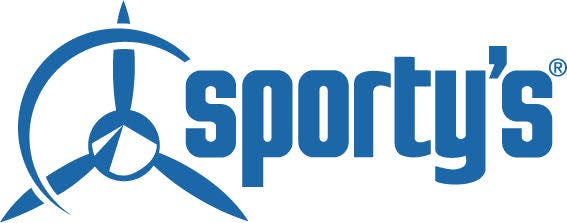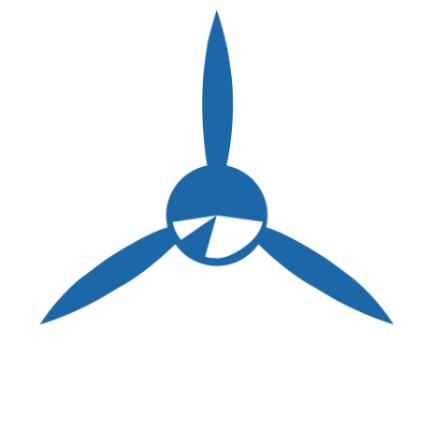Learn to Fly Frequently Asked Questions
Learning to fly is one of the most challenging yet rewarding experiences someone can endure. Traveling via three dimensions rather than two is an exciting way to commute to new places, share memories with friends and family, and enjoy some views that’ll make you feel anxious to book your next flight. But learning to fly an airplane isn’t as difficult as most people think. In this article we’ll cover the top asked questions when it comes to learning how to fly.
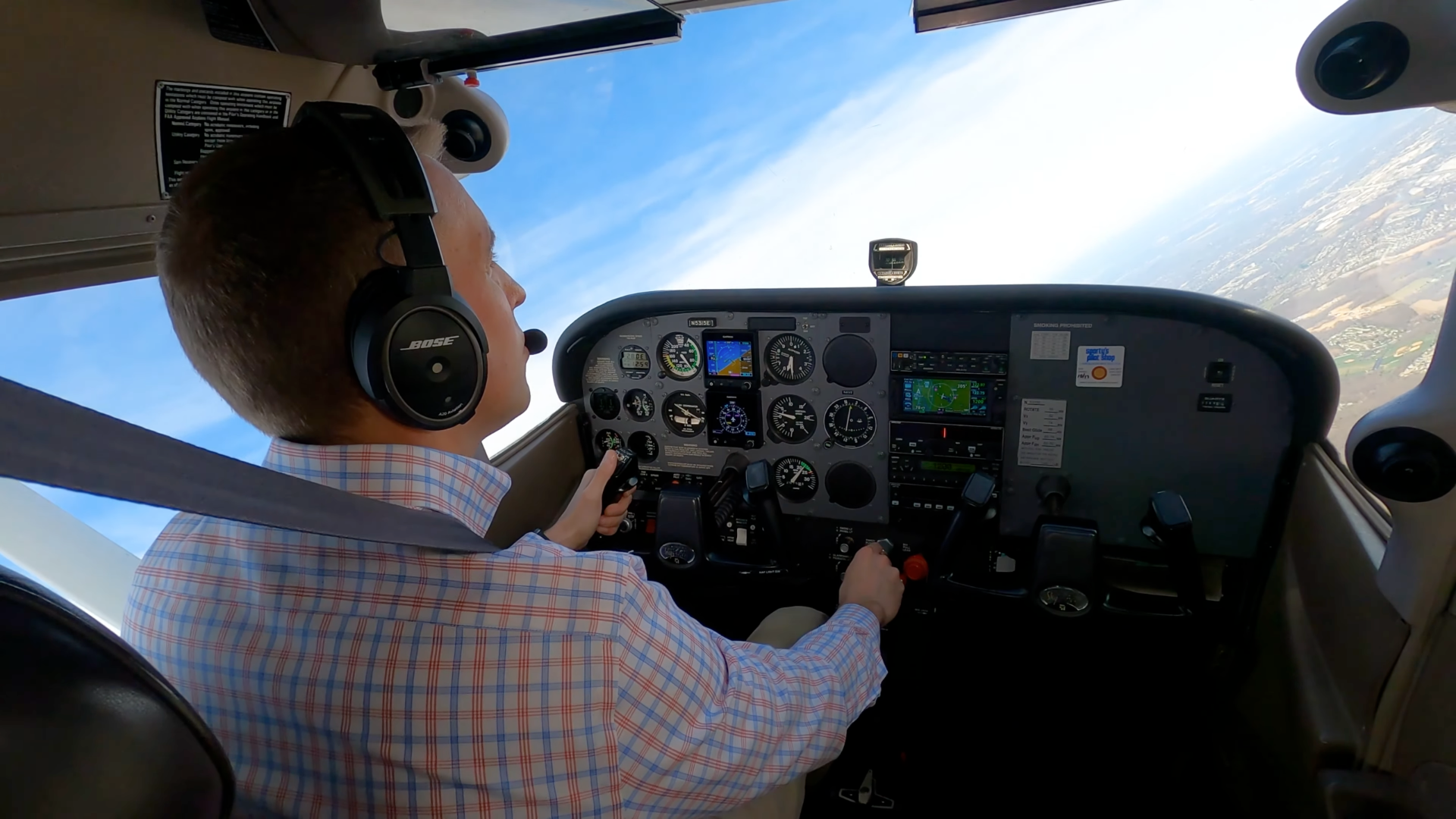

![]()
Basic Questions
5/1 - Why Should I Learn How to Fly a Plane?
Learning to fly a plane will unlock possibilities rarely considered and give you a renewed sense of freedom to explore the world. It is a truly unique experience. It is challenging, rewarding and flat out fun!
Some people start flying to make a career out of it, eventually working as a professional pilot.There are more than 800,000 pilots in the US. There are numerous jobs in aviation besides wearing stripes for the well known airlines. Career opportunities include business aviation pilot, flight instructing, cargo airlines, military flying, law enforcement and many more.
For others, flying is a convenient and cost-effective method of personal or business travel. You can set your own schedule, use airports that airlines don’t serve and leave the hassles of security lines behind. You have the ability to leave when you want to, and there’s no extra charge for that second bag. For business use, airplanes allow you to do more in one day than you could do in a week traveling by airline. Flexibility, privacy, security and freedom are all great reasons to use a personal airplane for travel.
In the end, many pilots fly for the enjoyment and shared memories that are tied into leaving the bounds of earth. Whether you’re taking an early morning sunrise flight to grab a quick bite at a distant (by driving standards) airport restaurant, or visiting friends and family. Pilot’s are happy to welcome others to local fly-ins at airports, or you can take a tour of your neck of the woods. There are countless opportunities that flying an airplane offers to us, and until you’ve looked through the front of an airplane as it takes off, you won’t know what you're missing.
It’s time to take your next step toward earning a pilot certificate, so stop dreaming, and start flying!
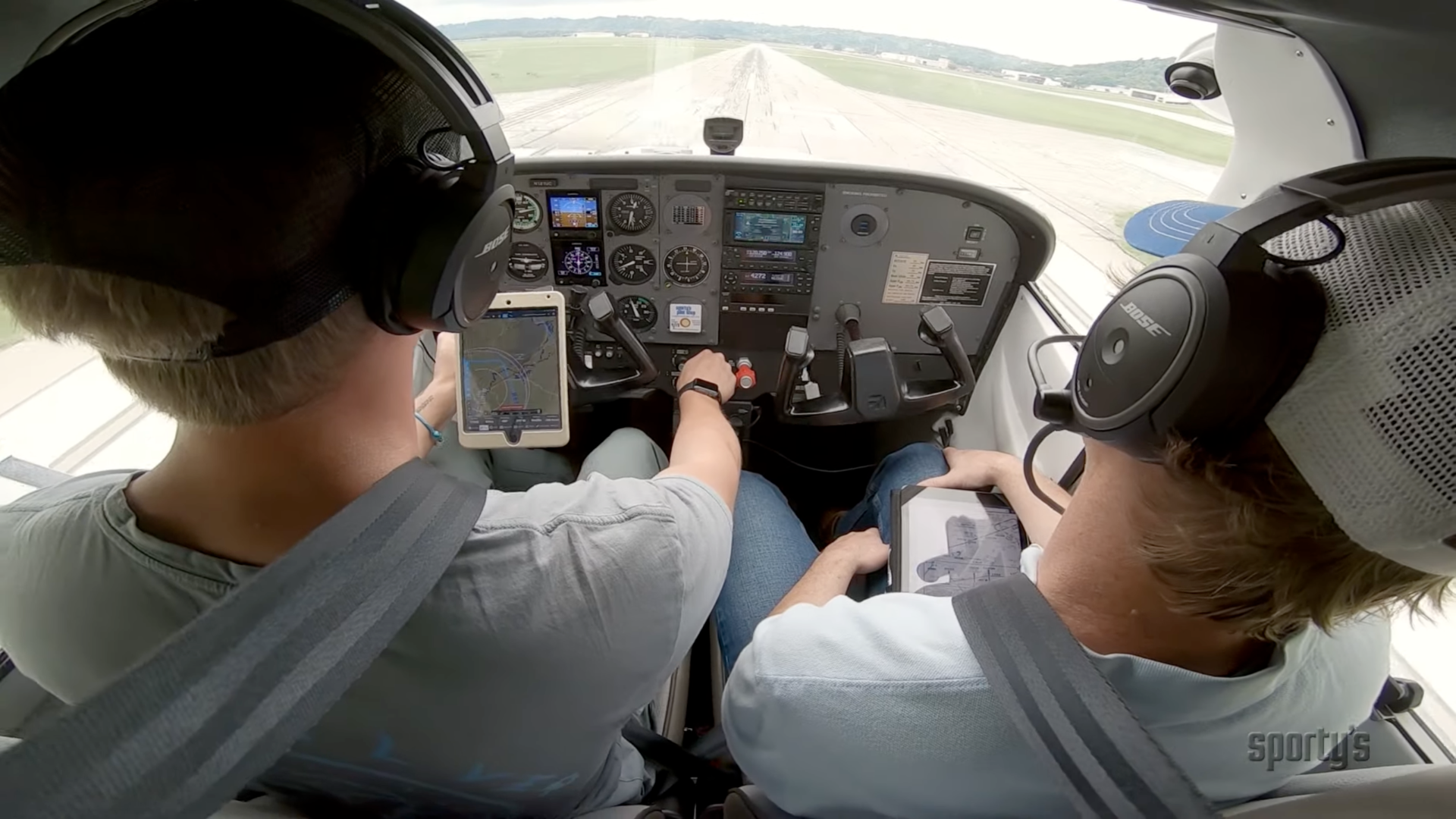
5/2 - How to learn to fly a plane?
Once you’ve made the decision, I’m going to learn to fly, the next question is how do I learn to fly? The following steps are our recommendation of the process and what will set you up for success in training:
- Locate a flight school in your area (search our database)
- Take a tour of your local flight schools and select the option that fits your needs (here’s how)
- Communicate your goals with your instructor (I want to become a pilot as a hobby, I’m learning to fly for my small business, I want to be an airline pilot, etc.)
- Enjoy a discovery flight or first flight lesson (video preview)
- Purchase a home study course to begin the ground school portion of training and prepare for the FAA knowledge
- Decide whether you’ll pursue the Sport, Recreational or Private Certificate (read more here)
- Schedule an FAA medical exam with a local AME (not required for the Sport certificate)
- Begin flight training (The FAA requires a minimum of 40 hours flight time for a Private Pilot Certificate)
- Pass your FAA Knowledge Test
- Pass your FAA Flight Test and earn your license
5/3 - How much does it cost to learn to fly a small plane?
No one wants to pay too much for a product or service, and it’s certainly no different with learning to fly. Learning to fly involves some expense, but it’s important to examine this expense as an investment that will provide a lifetime of return. The extent and depth of the training you will receive for your money makes learning to fly one of the all-time great bargains compared to many other recreational or business pursuits. For your investment, you will acquire the basic skills needed to safely enjoy an extraordinary and unique activity for years to come–a pilot’s license never expires!
Cost varies by flight school, certificate, and geographic location, but it is usually about the price of a luxury cruise for a week (anywhere from $12,000 to $15,000). And, you can pay as you go at most schools, so there’s no large payment due up front.
The good news is you can control much of what you spend and take steps to make your training more efficient. Frequency of training has the greatest impact on your total investment. Sporty’s recommends a frequency of two to three lessons per week for the best efficiency. A lesson costs about $250 - $300, which translates to $2,000 - $3,000 per month over the course of your training (about four to five months).
By the Numbers: Cost of flight training
- Lesson cost: $250-$300
- Per month cost: $2,000-$3000
- Length of training: 4-5 months
- Total cost of training: $12,000 - $15,000
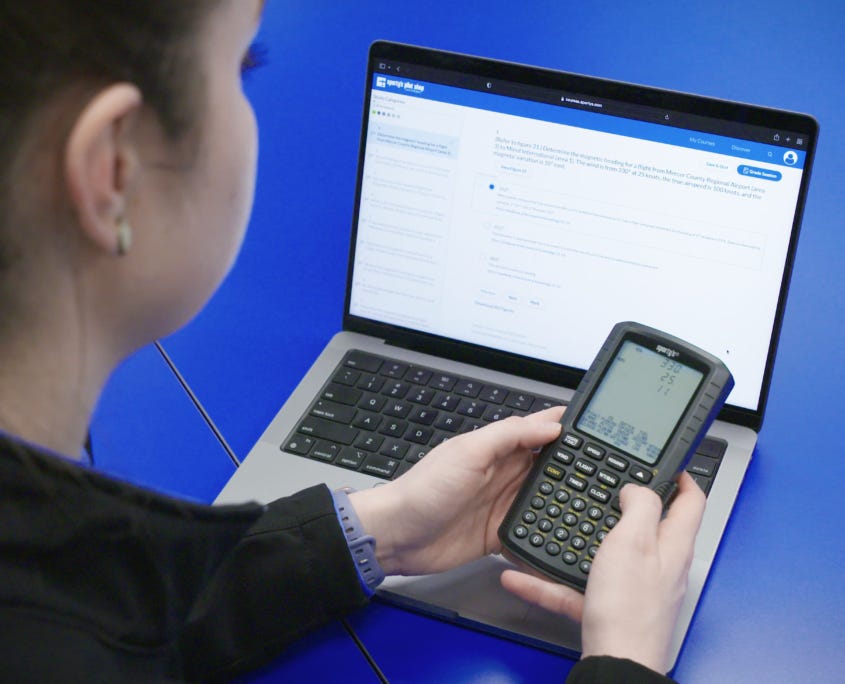
5/4 - How hard is it to learn to fly a plane?
It isn’t as difficult to fly an airplane as many believe. You don’t need to be a brilliant scientist or mathematician and you don’t need perfect eyesight. The most important traits for a flight student is a willingness to learn new things and a desire to learn outside of the hours spent with an instructor. If you’re persistent and committed to the training process, it’s easier than a lot of challenges in life.
Here are six bad habits we advise students to avoid in flight training:
- Don’t be late for your lessons - This is an obvious, but sure-fire way to get off on the wrong foot with your training. Not only will your instructor be annoyed, but you’ll soon realize how much money that wastes over time. Flight time isn’t free. The more delays you encounter, the more time you’ll spend learning the material. Do yourself a favor and aim to be there 30 minutes early for every lesson. You'll have time to review your notes from the last session and get a head start on your preflight.
- Don’t go broke - This is good advice for any endeavor, but it definitely rings true with flight training. Lack of continuity is a killer. Better to wait a couple of months to save up so you can take your lessons one after the other than to have long breaks in between your flying lessons. There are many options like flight simulator and online training courses that will help you save money on your training. Consider utilizing these resources to preserve your money for flight time.
- Don’t go it alone - Find the pilot community, join an organization like EAA or AOPA, and make an effort to make new friends at the airport who are either going through the same training or can mentor you. It’s a friendly group of people that can boost your encouragement on learning to fly.
- Don’t lose sight of the fun - Taking the time to enjoy your flight training can be really helpful. You’ll be more confident if you’re enjoying your lessons. Adn the more confidence you have, the faster you’ll pick up the skills needed to become a great aviator. So what do you do to have more fun while flying? Add a breakfast or lunch run to your cross countries. The almighty hundred dollar hamburger is a perfect way to lift you and your instructor’s mood.
- Don’t get discouraged - Just because your last landing wasn’t the best doesn't mean your next one won’t be. Stay on the wagon–you're building a skill set that takes time to acquire. It won’t happen overnight, but it will happen with practice and study. Something that not every pilot will tell you is that learning plateaus are common and nothing to stress about. Talk with your instructor and start mixing up your lessons so you don’t stall in your training.
- Don’t rely on YouTube - Everyone on YouTube thinks they’re an expert, but few of them are. Relying on these short videos to learn aerodynamics is a bad idea. The person you YouTube is probably not as good of a pilot as they say they are, just like people on Instagram aren’t actually as happy as they would have you believe. While there are plenty of online resources to aid your training, we recommend that you verify the source before taking their word for it. YouTube is great for sparking the passion for flying or getting ideas for new places to visit, but don’t depend on it for technical knowledge and in-flight instruction.
5/5 - How old do you have to be to learn how to fly a plane?
Aviators come from all kinds of backgrounds, each with unique reasons for flying. You can take lessons at any age—there is no minimum and no maximum. You must be 16 years old to solo and earn a student pilot certificate, and 17 to earn a Private certificate and carry passengers. You must be 18 to earn a Commercial pilot certificate. You can fly a balloon or glider at 14.
![]()
Getting Started
5/6 - Learn how to fly a plane near me
Flight training is a healthy mix of ground study or flight time with an instructor, as well as learning and research from the comfort of your home. Unless you’re able to relocate for your flight training, you’re going to want your flight school and home to be relatively close.
Use our Flight School Directory Tool which includes nearly 1,000 locations for help in finding the right flight school for you.
5/7 - I want to learn how to fly a plane, now what?
The process of learning to fly can seem overwhelming at first. But you can do it, and our team of flight instructors here at Sporty’s can help. That’s why we’ve developed this quick checklist of key steps to help you become a pilot:
- Locate flight schools in your area (search our database here)
- Take a tour and choose a school that best fits your needs (here’s how)
- Talk to your instructor and share your goals (if you’re interested in becoming a professional pilot, read this)
- Take a first flight lesson (watch a video preview)
- Purchase a home study course to prepare for your lessons and your FAA tests (free demo here)
- Decide whether you’ll pursue the Sport, Recreational or Private Certificate (compare them here)
- Schedule an FAA medical exam with a local AME (not required for Sport)
- Pass your FAA Knowledge Test
- Pass your FAA Flight Test and earn your license
- Have fun!
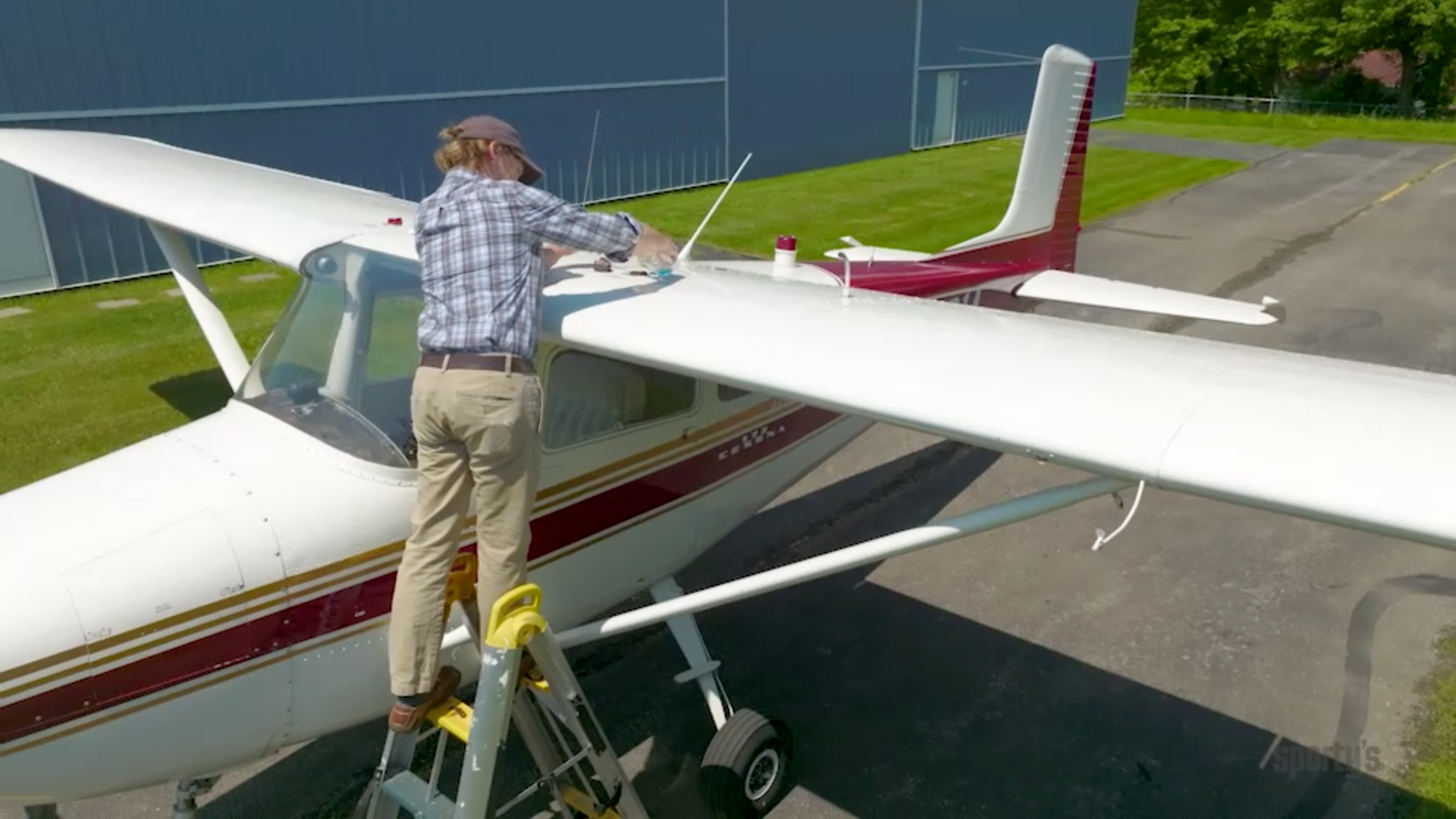
5/8 - How long does it take to learn to fly a plane?
The good news is that you can control a lot when it comes to how long it will take to earn a certificate. Your preparation (at-home study) and frequency of training has the greatest impact on your total time investment. Sporty’s recommends a frequency of two to three lessons per week for the best efficiency. At this pace, you can expect to earn your license in just a few months.
And when you come to the airport prepared, it will be a more enjoyable experience and a more efficient use of your time. Consider investing in a home-study program (free demo here) so that you can review after your lessons and be prepared for your next flight.
5/9 - Can I learn how to fly a plane online?
There is a lot related to learning to fly that can be accomplished online through video-based instruction, simulators and other learning tools. For example, a pilot can complete an entire ground school online and even be prepared to take the written exam for a pilot’s license. A pilot can also prepare extensively for flight lessons through the use of simulators and instructional video; however, online learning will have to be combined with in-person flight instruction at a flight school to be qualified and prepared for a pilot’s license.
5/10 - Best Book to learn how to fly a plane?
Known as the industry experts in flight education, Sporty’s authored a book, Learn to Fly: A Comprehensive Guide to Private Pilot Training. Filled with honest advice from Sporty’s team of flight instructors, this book is the aspiring pilot’s introduction to the fascinating world of aviation and a step-by-step guide to the flight training process. From finding a flight school to dealing with training setbacks to acing an airline interview, readers will learn detailed tips for success.
Learn to Fly is an essential reference for pilot training, whether learning to fly for fun or to launch a career. Written with clarity and expertise, and loaded with color graphics and helpful checklists, this comprehensive guide also includes dozens of helpful links to expand the reader’s knowledge online.
Read a sample from Sporty’s Learn to Fly book here.
Learn to Fly also explores the personal growth and transformation that accompany the pursuit of flight. Readers will experience the support and camaraderie forged among fellow aviators, the thrill of overcoming self-doubt, and the profound sense of accomplishment that comes with earning a pilot’s license.
Learn to Fly: A Comprehensive Guide to Private Pilot Training is offered in a convenient digital (ebook) format or in paperback for just $4.99. Already a Sporty’s course user? The digital version is a free resource as part of Sporty’s online Learn to Fly Course; the print version is available at Sportys.com or by calling 1-800-SPORTYS.
5/11 - What is a discovery flight?
A discovery flight, also referred to as an introductory or familiarization flight, is an introduction to small aircraft flying including preflight, basic aerodynamics and the four fundamentals. Typically, a flight instructor will show you how pilots inspect their aircraft prior to taking off. You’ll learn about the different parts of the airplane including the flight controls and what they do. You’ll learn what all the dials and displays on the instrument panel are for. But that’s not the best part. You will taxi and actually take off on a 30-minute flight where you will (with your flight instructor sitting next to you) fly the airplane yourself. Many discovery flights also culminate with an official logbook entry recording your flying time and plenty of pictures, videos and memories of the flight.
5/12 - What will I need for my first lesson?
For your first flight lesson, you will only need your enthusiasm and eagerness to learn. The flight school will have some basics to get you through your first lesson like an aviation headset and even a beginner logbook to record your training. You’ll also want to wear comfortable clothing and shoes (no open-toed shoes for safety reasons).
If you’re looking for a head start on your training, you could consider a home-study course such as Sporty’s Learn to Fly Course which comes with unlimited access and lifetime updates. You’ll also eventually need to consider an aviation headset, fuel tester, permanent logbook, flight calculator and perhaps a flight bag to store your items. Sporty’s Deluxe Learn to Fly Course Kit is a convenient way to get it all.
It’s also common for pilots to utilize an iPad to display digital charts and other flight planning resources which will likely require a subscription.
5/13 - What are the health requirements for learning to fly?
The pursuit of most pilot certificates will require you to obtain and hold an FAA Medical Certificate prior to flying solo. That doesn’t mean you have to have perfect vision or a spotless medical history.
If you are pursuing a Sport Pilot Certificate and will only be flying solo in a Light Sport Airplane, you may be able to use your valid driver’s license as a testament to your acceptable health.
If you are learning to fly in a glider, motorglider, or balloon, you will not need a medical. You will simply need to be able to attest to the fact that you do not have any medical conditions that would preclude your safe operation of the aircraft in solo flight.
FAA Medical Certificates are issued by an FAA Designated Aviation Medical Examiner (AME). AME’s are physicians with a special interest in aviation safety and have training in aviation medicine.
If you are in good health and ready to obtain your FAA Medical Certificate, find an AME, schedule an appointment, and fill out your application on MedXPress before going to see the doctor. You can find an AME using the FAA’s database found at https://www.faa.gov/pilots/amelocator/.
Learn more about medical requirements for pilots at FlightTrainingCentral.com.


5/14 - Am I too old to learn to fly?
There is no maximum age to learn to fly. Any person that is in reasonably good health, and who has a desire to learn, can be successful at learning to fly. The pursuit of most pilot certificates will require you to obtain and hold an FAA Medical Certificate prior to flying solo. You can learn more about that process at FlightTrainingCentral.com.
- In 2023 the average age of all student pilots was 35.2 years old.
![]()
FAA Test Prep
5/15 - How much does it cost to Learn to Fly a helicopter?
As a rough estimate, learning to fly a helicopter can cost anywhere from $15,000 to $30,000 or more, depending on a number of factors. Larger and more complex helicopters will cost more to operate than smaller, simpler ones. Geographic location will also result in differences in rental fees, fuel costs and instructor rates. It's crucial to research and get detailed quotes from helicopter flight schools to get a more accurate understanding of the costs involved.
5/16 - How hard is it to learn to fly a helicopter after flying a plane?
While there will be a lot of aviation knowledge such as regulations, airport operations and weather that would transfer from an airplane to a helicopter, there are significant differences in their operation and handling characteristics. While airplane pilots primarily use ailerons, elevator and rudder for control, helicopters use cyclic, collective and anti-torque pedals.
Further, airplanes rely on forward airspeed and lift generated by wings while helicopters can hover, fly vertically and even fly sideways. This makes for a more complicated control scheme for helicopters.
5/17 - How to learn to fly in X-Plane?
X-Plane 12 is a great flight simulation program for pilots to keep the rust off of certain maneuvers or system flows. With 30 different aircraft included in the native package, alongside thousands of additional airplanes within their store, you’re sure to find the “digital” airplane that matches what’s in your hangar or what you use for flight training.
One of the best starter features for X-Plane 12 is their flight training module that will cover the following flight conditions:
- X-Plane Basics
- Takeoff in the Cessna 172
- Taildragger Takeoff
- Landing in the Cessna 172
- Traffic Pattern
- VOR Navigation
- Flying an ILS Approach
Additional Resources:
5/18 - What is a Preflight?
Every flight really begins before the engines are even started. Part of this process is called the preflight inspection. The reason for an airplane preflight inspection is to ensure that all systems are working properly and that enough fuel and oil is on board for the intended flight. It's your chance to really look the airplane over inside and out to assure yourself that it's ready to fly.
The preflight really begins as you approach the airplane. Look at its general appearance for such items as fuel or oil leaks, flat or underinflated struts and tires, snow, ice or other obstructions on or near the airplane. After this general overview, it's time to get specific.
It's a recommended practice to use a written checklist during the preflight. This ensures all necessary inspections are completed and gets you in the habit of doing things the same way each time. All procedural checklists are included in the pilot's operating handbook. Some airplanes have separate checklists taken from the handbook for use during the preflight.
5/19 - What are the basics of a takeoff?
To begin the takeoff roll, add power smoothly and continuously. The throttle should be fully forward within five seconds. As the airplane begins to roll, pick a spot or an object beyond the end of the runway in line with the centerline. This reference point is essentially an extension of the centerline, and helps you keep the airplane on a straight course after takeoff.
The rudder pedals are used to maintain directional control. Certain factors make the airplane want to turn to the left; this is overcome by the use of right rudder. Wing position is maintained with aileron control.
The rudder pedals, thru nose wheel steering, maintain directional control at slow speeds. The rudder becomes more effective as airflow over it increases. By liftoff speed the airflow over the rudder is great enough to provide directional control.
As the airplane accelerates to takeoff speed, ease back on the control wheel just enough to let the airplane fly itself off the runway. Takeoff attitude is now established. This initial attitude is slightly nose high and is similar to the normal climb attitude.
5/20 - What are the basics of a landing?
When lined up on final, full flaps are extended for a normal landing and the airplane is trimmed for the recommended final approach speed.
From here on in, the glide path, or descent path, is set. The glide path is like a line that extends from the intended touchdown point to the airplane. The airplane should never be allowed to go below this path. The other fixed value is the approach speed, and you should never allow the airplane to go below the approach speed.
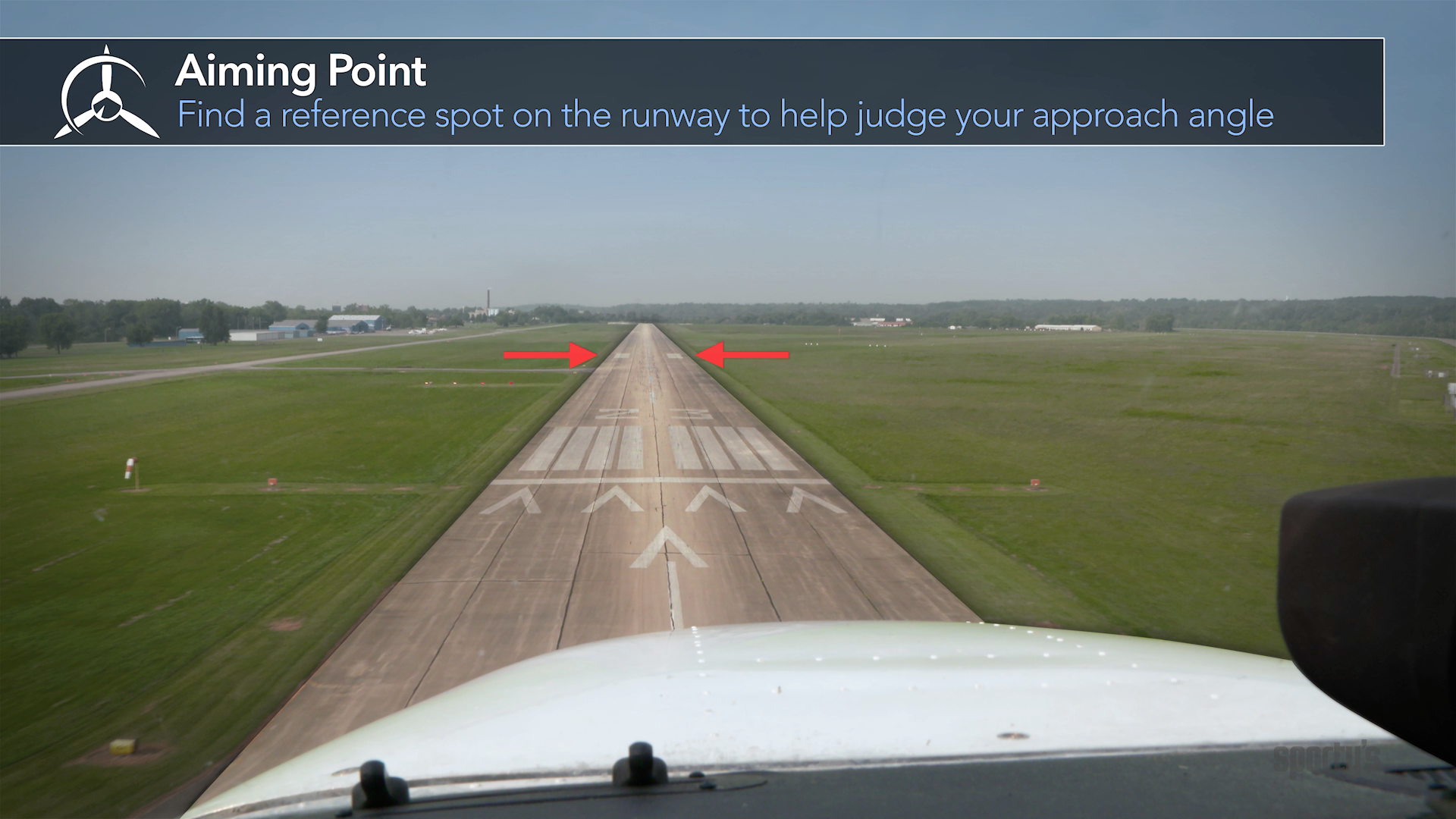 Select an aiming point down the runway. This can be a point between runway lights, or a particular mark on the runway. The aiming point is not the intended touchdown point, just a reference point.
Select an aiming point down the runway. This can be a point between runway lights, or a particular mark on the runway. The aiming point is not the intended touchdown point, just a reference point.
During the approach, align the aiming point with a place on the windshield. If the aiming point stays on the same place on the windshield, then you're on the right glide path. In addition to controlling the glide path, keep the airplane aligned with the runway.
As the airplane gets ten to twenty feet above the runway, the nose is raised to begin the landing 'flare.' The rate of descent is noticeably reduced and the pilot lets the airplane slowly get closer to the runway. The nose keeps coming up as the airplane flies about a foot or so above the runway. Finally, the airplane touches down on the main gear with the nose wheel well above the runway.
Maintain directional control with the rudder pedals until the aircraft loses speed and you can taxi clear of the active runway.
5/21 - What is a traffic pattern?
The airport traffic pattern is the "flow" of airplanes around the airport. A left-hand pattern (all turns to the left) is considered standard and should be used unless specified otherwise for an airport. The departure leg is the direction the airplane is flown on takeoff. The airplane is on the crosswind leg when it is flown at a ninety-degree angle to the landing runway and off its takeoff end. You're on the downwind leg when you fly parallel to the landing runway but in the direction opposite to landing. The base leg is flown at a ninety degree angle to the landing runway and off its approach end. The airplane is on the final approach leg when it is aligned with the landing runway and therefore, heading into the wind.
How to fly a standard traffic pattern (blog)
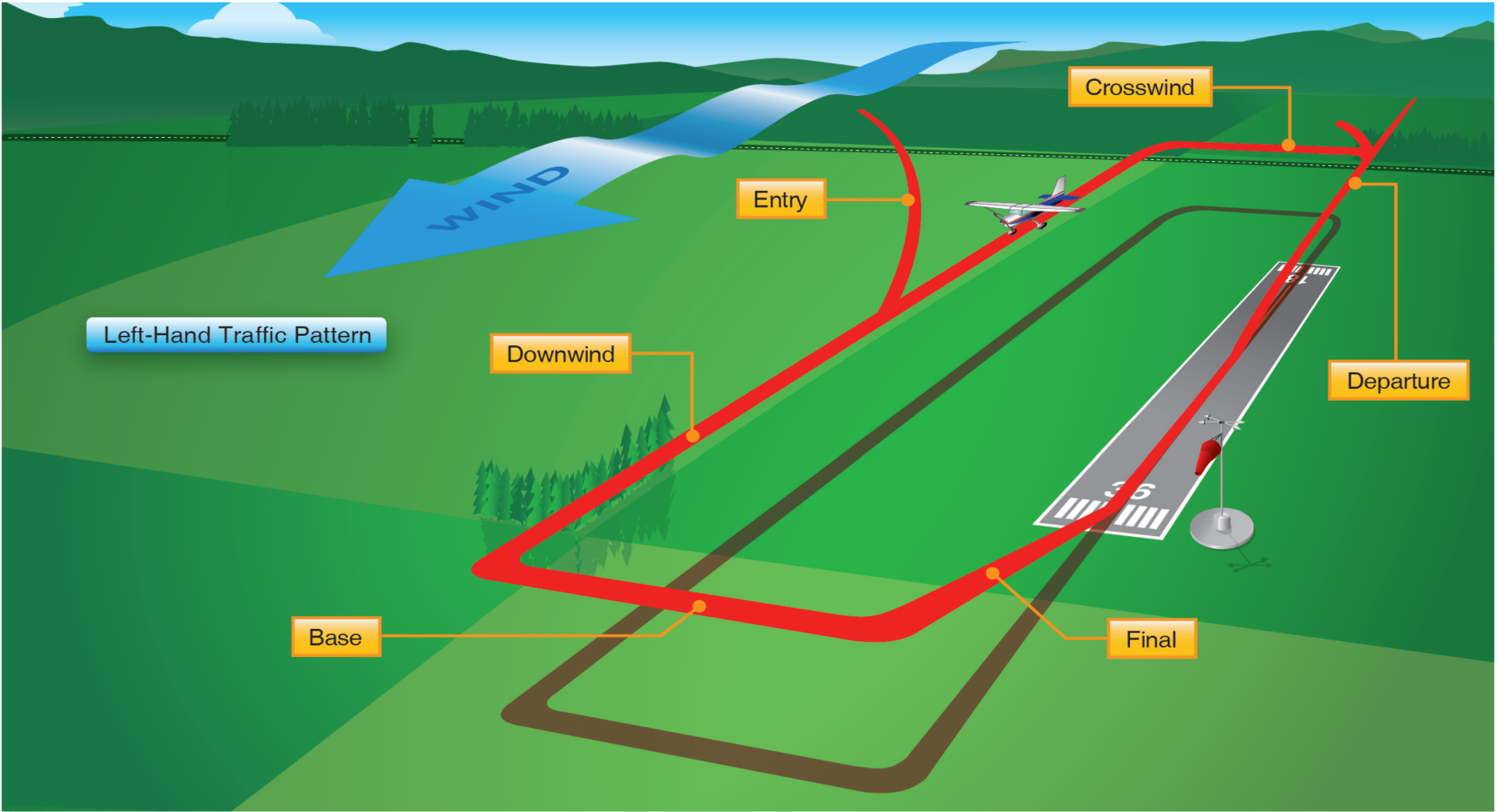
5/22 - Tricycle vs. Taildragger training?
Tricycle gear aircraft are generally easier to handle and are more commonly used for initial pilot training. Tailwheel aircraft offer a different set of challenges and skills, making tailwheel training valuable for pilots looking to expand their experience and proficiency. Tricycle gear aircraft offer more inherent stability, especially during ground operations and in windy conditions and therefore, require less emphasis on ground handling techniques. Tricycle Gear aircraft are also more readily available at flight schools.
5/23 - What does airspace look like?
The purpose of the different airspace rules is safety. Some areas of the US have more flights than others. Therefore, the FAA has implemented classes of airspace to reflect this activity. The level of control goes from zero in some areas to considerable control around congested, big city, airports that serve considerable airline traffic.
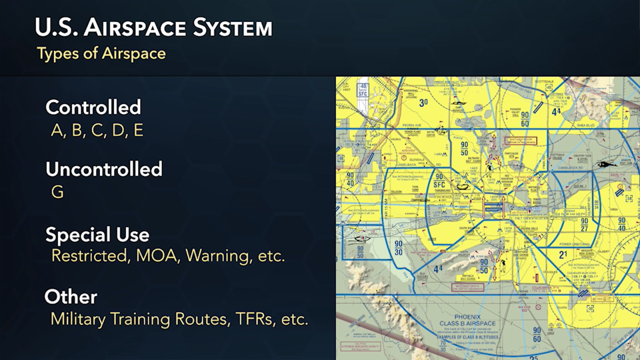
Airspace can be divided into Controlled, Uncontrolled, Special Use and Other. Airspace designation is determined by considering the density of aircraft, the types of operations, the level of safety required, and the national and public interest. Controlled airspace is generally where ATC service is provided. There are different requirements if the flight is operated under Instrument Flight Rules (IFR) or Visual Flight Rules (VFR). For example, a pilot flying IFR in controlled airspace will have to file an IFR flight plan and receive an ATC clearance. For VFR flight, controlled airspace means increased cloud clearance and visibility requirements. For the VFR pilot flying in B, C, and D airspace, there are communication and/or clearance requirements.
US airspace conforms to the International Civil Aviation Organization (ICAO) system. ICAO classifies airspace by the letters A through G with A being the most restrictive and G having the least constraints. There is no Class F airspace because the US has no equivalent to ICAO Class F where ATC provides separation for IFR aircraft only as practical.
For more information, see the Pilot’s Guide to Airspace at FlightTrainingCentral.com
5/24 - Can I fly at night?
Student and Recreational pilots may fly at night if properly trained and endorsed. Private and Commercial pilots are permitted to fly at night. In order to be current to carry a passenger, a pilot must have completed at least three takeoffs and landings in the preceding 90 days in the same class of airplane (i.e. single engine). The regulation is specific in that the landings must be to a full stop and have occurred during the period of one hour after sunset to one hour before sunrise.
5/25 - Why do airplanes stall?
Contrary to popular belief, an airplane stall has nothing to do with the aircraft's engine. When your lawnmower or car stalls, it has to do with an engine issue. In aviation, a stall involves a lack of airflow over the aircraft’s surfaces.
Simply stated, angle of attack is the angle between where the wing is pointed and where it's actually going. Lift is created by increased pressure below the wing and decreased pressure above the wing. At a low, positive angle of attack, most of the lift is caused by the decrease of pressure above the wing. As the angle of attack increases, the lift caused by the higher pressure below the wing also increases.
Total lift increases as the angle of attack increases, but eventually the angle of attack becomes so large that the airflow can't make the rapid change in direction needed to follow the top contour of the wing. When this happens the airfoil has reached the stalling angle of attack, sometimes called the critical angle of attack or the burble point. The wing is still producing some lift, the problem is that it's not producing enough lift to support the airplane and it has not reached an aerodynamic stall.
5/26 - What to expect on a checkride?
The checkride for most is an intimidating test. Knowing that an examiner is the final hurdle between the student pilot and their next certification or phase of training can cause the jitters to begin. One mantra to keep in mind is this; A good examiner will approach the checkride of the mindset that you’re a licensed pilot unless given reason to believe otherwise. This is an important distinction from the belief that it’s up to you to prove your worth.
Regardless of the mental preparedness there are do’s and don’ts for the day. Here are our recommendations of how to set yourself up for success: For your checkride, DO:
- Learn the examiner ahead of your checkride and study the expected profile
- Complete the details - 8710 application, logbooks, written exam results, flight plan, payment all in order
- Review all of the airspace along your cross country route, as well as chart symbology ahead of the checkride
- Study your aircraft’s limitations and memory items - examiners typically start the oral portion of a checkride with aircraft questions
- Relax in between maneuvers and don’t rush to the next
- Remember that you’re the Pilot In Command and fly as you have been trained
- Review the appropriate ACS to ensure that you are comfortable and familiar with what is to be expected
- Review popular oral exam questions. Flashcards are a great option.
For your checkride, DON’T:
- Study obscure regulatory or AIM entries searching for the needle in the haystack
- Memorize answers. Learn the material, not someone else’s summary of the material
- Cram up to checkride time. Once you’re within two hours of the exam, put the study materials down and just relax
- You can always be better and no one expects perfection. When your CFI says you’re ready, go for it
- If you make a mistake, own it and move on
- Depart from your routine. Begin and end your days as you ordinarily would
- Second guess. Your first instinct is usually correct
5/27 - What are the benefits of a Private Pilot license?
A Private Pilot license builds on the privileges of a recreational and sport license, with a few additional allowances.
You CAN:
- Fly internationally
- Fly an airplane weighing 12,500 or less during the day or night
- Fly while carrying passengers with baggage
- Equally share the operating expenses of a flight with passengers
- Tow Gliders
- Be a Test Pilot
- Demonstrate an aircraft for sale (with 200 hours of logged flight time or more)
- Participate in search and rescue operations
- Provide airplane rides to raise money for a charity
- Fly into Bravo airspace
- Fly above 10,000 feet MSL up to but not exceeding 17,999 feet MSL
You CANNOT:
- Be paid to fly passengers or property
- Fly at or above 18,000 feet MSL
- Fly in Instrument conditions
A Private Pilot certificate is a springboard to build Pilot In Command time. You’ll additionally be well positioned to learn and understand new maneuvers, different types of airspace, as well as further building blocks towards becoming a professional pilot.
For more information read FAR 61.113 - Private pilot privileges and limitations: Pilot in command.
5/28 - What happens during a solo flight?
The first solo is a momentous day for any pilot. It’s when we unequivocally answer the question “can I fly an airplane by myself” and more often than not the student is ready, and then some. A first solo typically involves a student flying with their instructor for a few laps around the pattern to acquaint themselves with the day’s weather conditions as well as takeoff and landing technique. The instructor will typically ask the student to taxi the aircraft to the FBO so they can jump out and talk to the student through a handheld radio. The student will then taxi back to the runway and complete three laps around the pattern, each including a full stop landing. The day is usually celebrated with the cutting of the students shirt to signify they’ve successfully solo’d an aircraft!
To read more about solo requirements, click here.
Sporty's Academy first solo videos (2024)
![]()
Pro Pilot Tips
5/29 - How much does it cost to rent and fly a private plane?
Renting an airplane can range anywhere from $80 per hour (Piper Cub or a Cessna 150) up to $300 or $400 per hour in a multi engine aircraft (Piper Seminole or Aztec). Something important to distinguish when researching costs is whether the rates are for the aircraft “wet” or “dry”. If the rates are “dry” then the renter will additionally be responsible for purchasing fuel for the rental flight. 100 low lead (100LL) ranges from ~ $5.50 per gallon up to ~ $8.00 per gallon, depending on what part of the country you are in.
5/30 - How long does it take to learn to fly a commercial plane?
Flying a commercial plane will require that you obtain a series of certifications including Private pilot, Instrument Rating and Commercial pilot and build up a considerable amount of flying experience.
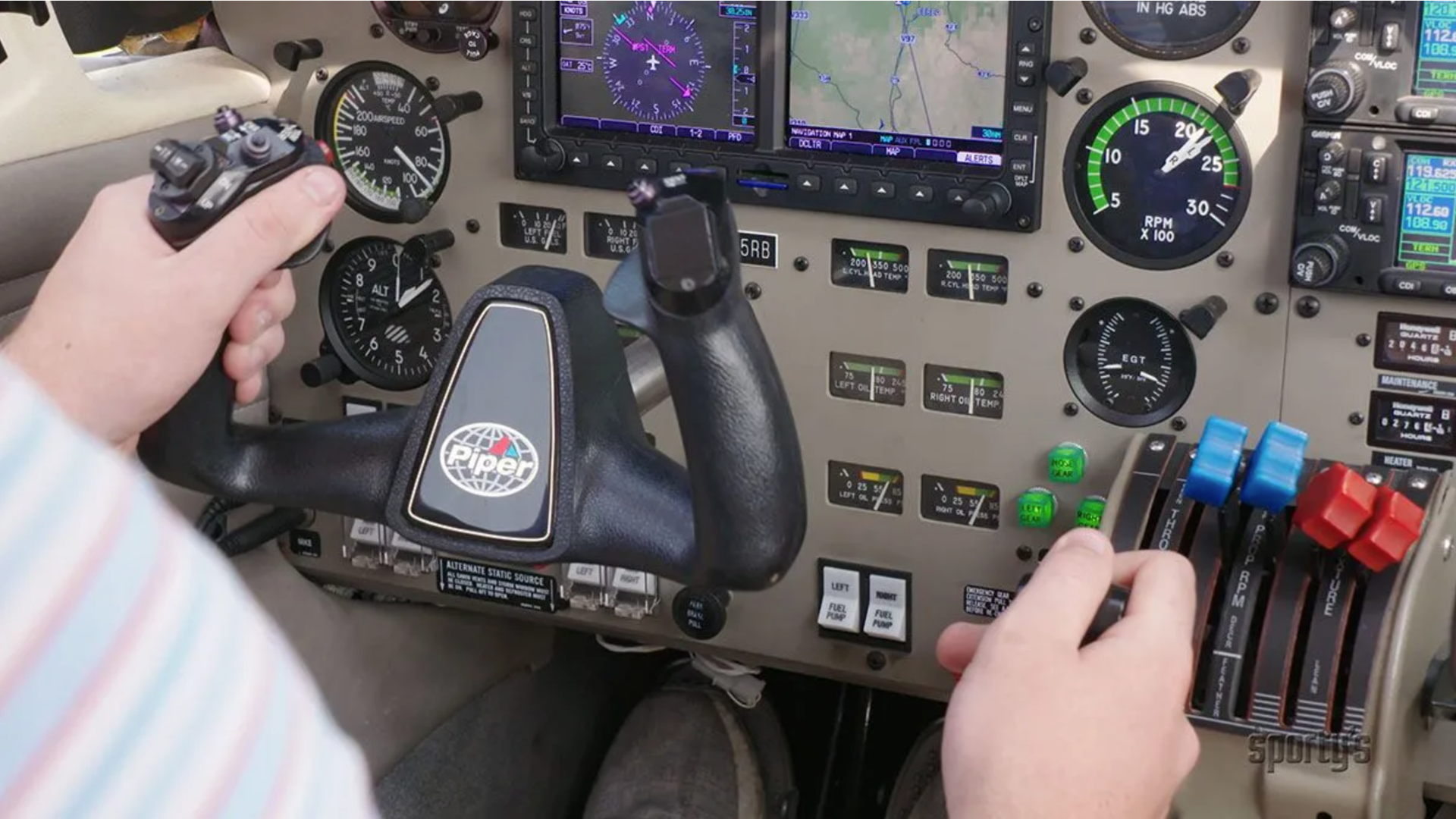 Obtaining a commercial multiengine rating opens you to almost every type of higher-level flying, as nearly all carrier or cargo operations operate multiengine airplanes. Many aviation jobs require a certain amount of time in a multi-engine airplane as well. For instance, to obtain your Airline Transport Pilot certificate, you are required to have a minimum of 50 hours of multiengine time.
Obtaining a commercial multiengine rating opens you to almost every type of higher-level flying, as nearly all carrier or cargo operations operate multiengine airplanes. Many aviation jobs require a certain amount of time in a multi-engine airplane as well. For instance, to obtain your Airline Transport Pilot certificate, you are required to have a minimum of 50 hours of multiengine time.
Most civilian-trained pilots also earn a certified flight instructor certificate (CFI). As a CFI, you are able to begin teaching students for private pilot and commercial training. This is a very common way to build hours to meet the minimums for the job you are looking for, whether it is cargo (many options open at 500 hours), charter or corporate (some options open at 1000 hours, some less), or airlines (ATP certificate, requires 1,500 hours).
Obtaining a Commercial certificate will likely take 12-18 months and then an additional 12-18 months to build the requisite experience to move into commercial flight operations.
5/31 - What are the private vs. commercial certificate benefits
The resounding benefit from transitioning from a Private Certificate to a Commercial Certificate is the legal ability to be compensated for flying. Whether flying packages across the country during the night, bush flying up in Alaska, or commuting passengers across the country, the Commercial Pilot can receive compensation. For a complete breakdown of the benefits from a Recreational to Commercial certificate, see below.
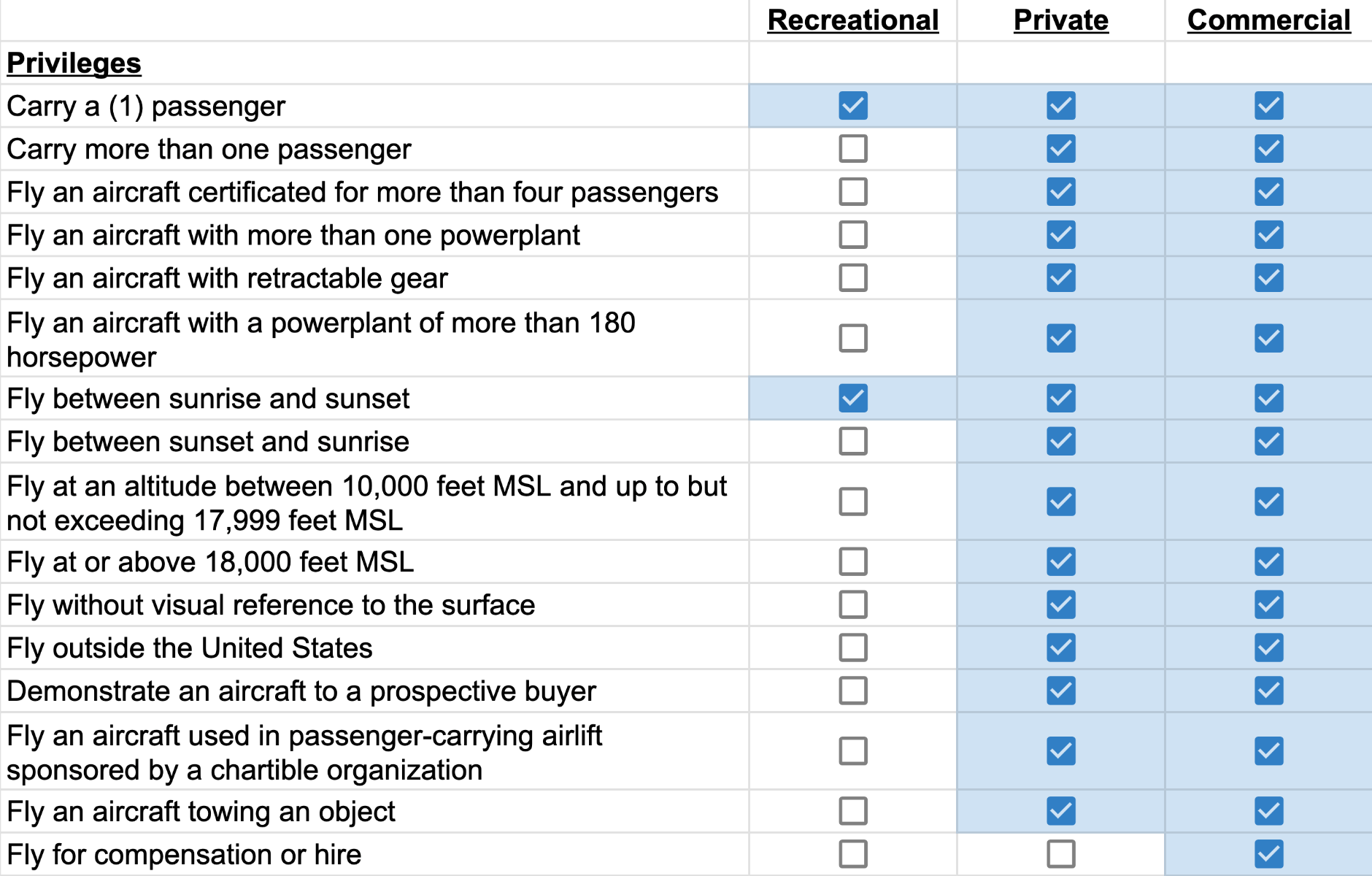
Recreational Pilot Privileges (61.101)
